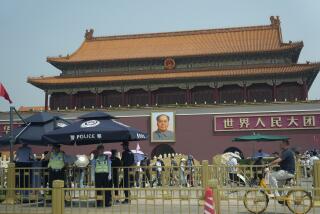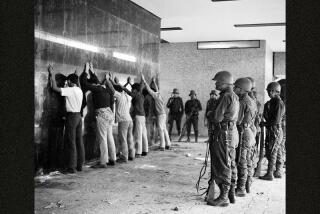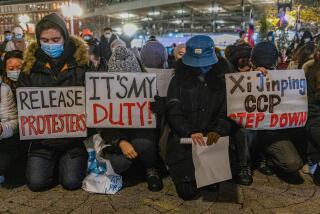Assault on the Square: A Chronology
- Share via
\o7 BEIJING\f7 — Key events in the student pro-democracy movement that led to the assault by soldiers on protesters in Tian An Men Square:
April 15--Former Communist Party chief Hu Yaobang dies. Beijing University students put up posters praising him and indirectly criticizing opponents who forced his resignation in early 1987 after student demonstrations in 1986-87.
April 17--Thousands of students march in Beijing and Shanghai, shouting, “Long live Hu Yaobang! Long live democracy!”
April 22--While official memorial ceremonies are held for Hu at nearby Great Hall of the People, students defy police orders to leave the square.
April 26--People’s Daily publishes major Communist Party attack on protesters, angering students.
April 27--More than 50,000 students, with wide support from people on the street, surge past police lines and fill Tian An Men Square, chanting slogans for democracy and freedom.
April 29--Officials meet with student leaders, but independent student groups are not satisfied and continue a class boycott at 41 universities.
May 4--About 100,000 students and supporters march on Tian An Men Square to celebrate the 70th anniversary of China’s first student movement. Demonstrations are held in Shanghai, Nanjing and other cities. About 300 journalists protest outside the official New China News Agency.
May 13--About 2,000 students begin a hunger strike in Tian An Men Square. Number later grows to 3,000.
May 15--The government deadline for students to leave the square passes. Soviet President Mikhail S. Gorbachev’s welcoming ceremony must be moved from the square to the airport.
May 17--Communist Party chief Zhao Ziyang pleads for students to leave the square. Students reject his appeal and hold marches that generate 1 million supporters in Beijing.
May 18--About 1 million people, including many workers, again take to the streets to show their support for the hunger strikers. Premier Li Peng issues a stern lecture to student leaders and refuses to discuss their demands.
May 20--Martial law is declared in parts of Beijing after Zhao reportedly fails to persuade Li and other hard-liners to compromise. Students resume their hunger strike, then abandon it, saying they need strength for the struggle ahead.
May 21--Students reject an order by Li Peng to leave Tian An Man Square or face military action. Defying martial law, hundreds of thousands of people remain in the square or block intersections to prevent troops from reaching it.
May 25--Li makes his first appearance since declaring martial law. State-run radio says 27 of 29 provinces support martial law, and military units announce they support martial law.
May 27--Beijing student leaders propose that students end their occupation of Tian An Men Square. Non-Beijing students resist and the sit-in continues.
May 30--Students unveil their “Goddess of Democracy,” a replica of the Statue of Liberty, on the square. The government calls it an insult to the nation.
June 1--The Beijing municipal government warns foreign journalists that under martial law they must receive approval for all press coverage. Coverage of the demonstrations is banned.
June 3-4--Tens of thousands of troops make several attempts to move on the square but are driven back by crowds of hundreds of thousands of people supporting the students. Riot squads beat and fire tear gas at demonstrators. A final push is made the evening of June 3, and soldiers begin firing on crowds. Troops surround and enter the square in the early morning hours of June 4 and thousands of protesters flee. Many are killed and hundreds are wounded.
More to Read
Sign up for Essential California
The most important California stories and recommendations in your inbox every morning.
You may occasionally receive promotional content from the Los Angeles Times.










